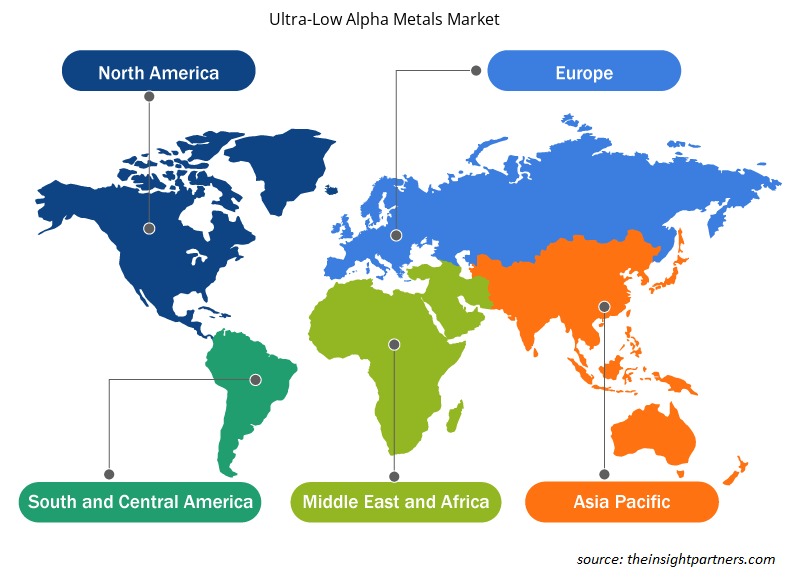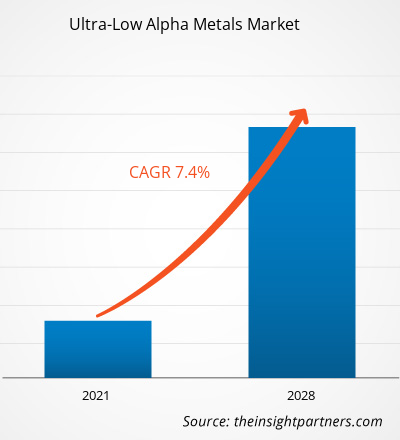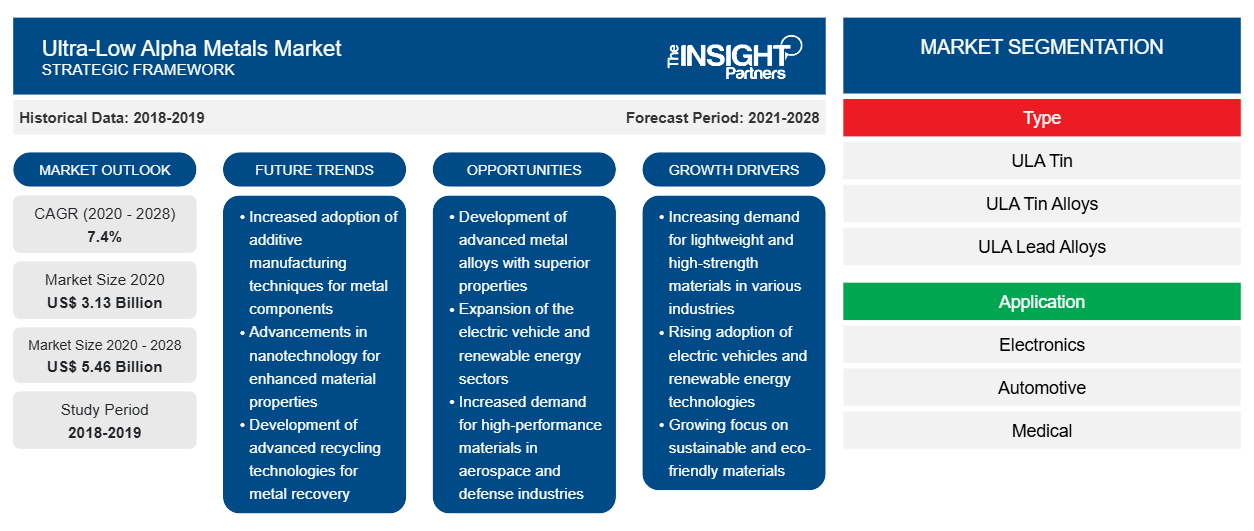[Rapporto di ricerca] Il mercato dei metalli alfa ultra-bassi è stato valutato a 3.125,00 milioni di dollari nel 2020 e si prevede che raggiungerà i 5.461,78 milioni di dollari entro il 2028; si prevede che crescerà a un CAGR del 7,4% dal 2021 al 2028.
I metalli alfa ultra-bassi sono usati principalmente nel solder bumping nell'industria elettronica. Le rigide normative governative sull'uso di sostanze pericolose nelle apparecchiature elettroniche guidano la crescita del mercato dei metalli alfa ultra-bassi. Tuttavia, la volatilità dei prezzi delle materie prime impedisce la crescita del mercato.
Nel 2020, l'area Asia-Pacifico ha contribuito alla quota maggiore del mercato globale dei metalli a bassissimo valore alfa .La crescita del mercato nella regione è attribuita principalmente alla presenza di una solida base industriale con importanti produttori. L'elevata domanda di metalli a bassissimo alfa da applicazioni quali elettronica, automotive e medicale, sostenuta da basi industriali di utilizzo finale in significativa crescita, sta stimolando la crescita del mercato dei metalli a bassissimo alfa nella regione.
Personalizza questo report in base alle tue esigenze
Riceverai la personalizzazione gratuita di qualsiasi report, comprese parti di questo report, o analisi a livello nazionale, pacchetto dati Excel, oltre a usufruire di grandi offerte e sconti per start-up e università
- Scopri le principali tendenze di mercato in questo rapporto.Questo campione GRATUITO includerà analisi di dati che spaziano dalle tendenze di mercato alle stime e alle previsioni.
Impatto della pandemia di COVID-19 sul mercato dei metalli a bassissimo alfa
L'attuale pandemia di COVID-19 ha drasticamente alterato lo stato del settore chimico e dei materiali e ha avuto un impatto negativo sulla crescita del mercato dei metalli alfa ultra-bassi. L'attuazione di misure per combattere la diffusione del nuovo coronavirus ha aggravato la situazione e ridotto la domanda di metalli e materiali industriali. Le operazioni delle industrie sono state influenzate dalla pandemia, che ha in definitiva disturbato il ciclo di consegna e aumentato le tariffe di importazione ed esportazione. L'improvvisa distorsione delle efficienze operative e le interruzioni nelle catene del valore sono attribuite alla chiusura improvvisa dei confini nazionali e internazionali e alla chiusura temporanea delle basi di produzione a causa di blocchi indefiniti e quarantene temporanee, che hanno ostacolato la crescita del mercato durante la pandemia. Le restrizioni sulla catena di fornitura con volatilità nei prezzi delle materie prime e nell'approvvigionamento a causa delle prime settimane di blocco hanno disturbato i prodotti e i processi industriali. Inoltre, l'attenzione sulla produzione just-in-time è un altro fattore preoccupante che ostacola la crescita del mercato. Tuttavia, poiché le economie stanno pianificando di rilanciare le loro operazioni, si prevede che la domanda di metalli alfa ultra-bassi aumenterà a livello globale nei prossimi anni. Si prevede che la crescente domanda di materiali industriali avanzati dovuta alla crescita di vari settori di utilizzo finale, come elettronica, aerospaziale e difesa, automotive, medicina e telecomunicazioni, guiderà anche la crescita del mercato nei prossimi anni. Inoltre, investimenti significativi da parte di importanti produttori nell'avanzamento di leghe senza piombo alfa ultra-bassi alimenterebbero la crescita del mercato dei metalli alfa ultra-bassi durante il periodo di previsione.lockdowns and temporary quarantines, which have hampered the growth of the market during the pandemic. The restrictions on supply chain with volatility in raw material pricing and sourcing due to initial weeks of lockdown have disturbed the industrial products and processes. Also, the focus on the just-in-time production is another concerning factor hindering market growth. However, as the economies are planning to revive their operations, the demand for ultra-low alpha metals is expected to rise globally in the coming years. The increasing demand for advanced industrial materials due to the growth of various end-use industries, such as electronics, aerospace & defense, automotive, medical, and telecommunication, is also expected to drive the growth of the market in the coming years. Further, significant investments by prominent manufacturers in the advancement of ultra-low alpha lead-free alloys would fuel the growth of the ultra-low alpha metals market during the forecast period.
Approfondimenti di mercato
Aumento delle preoccupazioni per il problema dell'errore soft per alimentare la crescita del mercato dei metalli alfa ultra-bassi
La crescente domanda di requisiti di prodotti ad alta densità e bassa potenza ha spinto il concetto di riduzione delle dimensioni e delle tensioni operative dei moderni dispositivi elettronici. Il costante ridimensionamento delle tecnologie dei dispositivi complementari metallo-ossido-semiconduttore ha portato alla miniaturizzazione e alla riduzione della tensione operativa dei transistor del dispositivo. Tuttavia, il concetto ha aperto nuove sfide, sia dal punto di vista della tecnologia che dei materiali. Uno di questi problemi è l'errore soft, il malfunzionamento temporaneo del dispositivo, causato dalla radiazione di particelle alfa ad alta energia. Una delle principali fonti di radiazione di particelle alfa sono le saldature che vengono utilizzate in modo significativo per unire i componenti nel packaging. Quindi, la crescente preoccupazione per il problema dell'errore soft ha portato a un aumento della domanda di metalli alfa ultra-bassi.
Tipo Informazioni
In base al tipo, il mercato globale dei metalli a bassissimo alfa è segmentato in stagno ULA, leghe di stagno ULA, leghe di piombo ULA, leghe senza piombo ULA e altri. Il segmento delle leghe senza piombo ULA e altri ha guidato il mercato nel 2020. Con i crescenti investimenti in attività di ricerca e sviluppo, i produttori stanno ideando forme avanzate di prodotti, che potrebbero soddisfare requisiti specifici del settore. Allo stesso modo, i produttori hanno introdotto leghe senza piombo ULA composte da una percentuale significativamente bassa di piombo (ad esempio, 0,1%) o niente piombo. La domanda di leghe di saldatura senza piombo a bassissimo alfa è in aumento a causa delle crescenti preoccupazioni per l'ambiente.ULA tin, ULA tin alloys, ULA lead alloys, ULA lead-free alloys and others. The ULA lead-free alloys and others segment led the market in 2020. With the growing investments in research and development activities, manufacturers are coming up with the advanced forms of products, which could meet specific industry requirements. Similarly, manufacturers have introduced ULA lead-free alloys that is composed of a significantly low proportion of lead (i.e., 0.1%) or no lead at all. The demand for ultra-low alpha lead-free soldering alloys is rising due to the growing concerns toward the environment.
Approfondimenti sulle applicazioni
In base all'applicazione, il mercato globale dei metalli alfa ultra-bassi è segmentato in elettronica, automotive, medicale, telecomunicazioni e altri. Il segmento dell'elettronica ha guidato il mercato nel 2020. È fondamentale implementare l'uso di leghe e metalli che potrebbero mantenere un grado alfa ultra-basso quando impiegati in applicazioni elettroniche. L'uso di metalli alfa ultra-bassi aiuta a evitare qualsiasi malfunzionamento causato da errori soft nei dispositivi elettronici. Inoltre, la significativa riduzione delle dimensioni dei dispositivi, insieme all'installazione di materiali di saldatura vicino alle posizioni sensibili nei dispositivi elettronici, genera la necessità di metalli alfa ultra-bassi. C'è un aumento della domanda di metalli alfa ultra-bassi nella produzione di elettronica di consumo.
Tra i principali attori che operano nel mercato globale dei metalli a bassissimo valore alfa ci sono MITSUBISHI MATERIALS Corporation; Teck Resources Limited; Advanced Manufacturing Services (AMS) Ltd; Pure Technologies; Honeywell International Inc.; DUKSAN Hi-Metal Co., Ltd; e MacDermid Alpha Electronics Solutions.
Segnala i riflettori
- Tendenze industriali progressive nel mercato dei metalli alfa ultra-bassi per aiutare gli operatori a sviluppare strategie efficaci a lungo termine
- Strategie di crescita aziendale adottate dai mercati sviluppati e in via di sviluppo
- Analisi quantitativa del mercato dei metalli a bassissimo alfa dal 2019 al 2028
- Stima della domanda globale di metalli alfa ultra-bassi
- Analisi PEST per illustrare l'efficacia degli acquirenti e dei fornitori che operano nel settore
- Sviluppi recenti per comprendere lo scenario competitivo del mercato
- Tendenze e prospettive di mercato, nonché fattori che guidano e frenano la crescita del mercato dei metalli a bassissimo alfa
- Assistenza nel processo decisionale evidenziando le strategie di mercato che sostengono l'interesse commerciale, portando alla crescita del mercato
- La dimensione del mercato dei metalli alfa ultra-bassi in vari nodi
- Panoramica dettagliata e segmentazione del mercato, nonché dinamiche del settore dei metalli alfa ultra-bassi
- Dimensioni del mercato dei metalli alfa ultra-bassi in varie regioni con promettenti opportunità di crescita
Approfondimenti regionali sul mercato dei metalli alfa ultra-bassi
Le tendenze regionali e i fattori che influenzano il mercato dei metalli ultra-low alfa durante il periodo di previsione sono stati ampiamente spiegati dagli analisti di Insight Partners. Questa sezione discute anche i segmenti e la geografia del mercato dei metalli ultra-low alfa in Nord America, Europa, Asia Pacifico, Medio Oriente e Africa e America meridionale e centrale.

- Ottieni i dati regionali specifici per il mercato dei metalli alfa ultra-bassi
Ambito del rapporto di mercato sui metalli alfa ultra-bassi
| Attributo del report | Dettagli |
|---|---|
| Dimensioni del mercato nel 2020 | 3,13 miliardi di dollari USA |
| Dimensioni del mercato entro il 2028 | 5,46 miliardi di dollari USA |
| CAGR globale (2020 - 2028) | 7,4% |
| Dati storici | 2018-2019 |
| Periodo di previsione | 2021-2028 |
| Segmenti coperti | Per tipo
|
| Regioni e Paesi coperti | America del Nord
|
| Leader di mercato e profili aziendali chiave |
|
Densità degli operatori del mercato dei metalli alfa ultra-bassi: comprendere il suo impatto sulle dinamiche aziendali
Il mercato dei metalli ultra-low alfa sta crescendo rapidamente, spinto dalla crescente domanda degli utenti finali dovuta a fattori quali l'evoluzione delle preferenze dei consumatori, i progressi tecnologici e una maggiore consapevolezza dei benefici del prodotto. Con l'aumento della domanda, le aziende stanno ampliando le loro offerte, innovando per soddisfare le esigenze dei consumatori e capitalizzando sulle tendenze emergenti, il che alimenta ulteriormente la crescita del mercato.
La densità degli operatori di mercato si riferisce alla distribuzione di aziende o società che operano in un particolare mercato o settore. Indica quanti concorrenti (operatori di mercato) sono presenti in un dato spazio di mercato in relazione alle sue dimensioni o al valore di mercato totale.
Le principali aziende che operano nel mercato dei metalli a bassissimo valore alfa sono:
- Mitsubishi Materiali Corporation
- Risorse Teck limitate
- Servizi di produzione avanzata (AMS) Ltd
- Tecnologie pure
- Honeywell International Inc.
Disclaimer : le aziende elencate sopra non sono classificate secondo un ordine particolare.

- Ottieni una panoramica dei principali attori del mercato dei metalli a bassissima alfa
Mercato globale dei metalli alfa ultra-bassi
Per tipo
- Latta ULA
- Leghe di stagno ULA
- Leghe di piombo ULA
- Leghe senza piombo ULA e altre
Per applicazione
- Elettronica
- Automobilistico
- Medico
- Telecomunicazione
- Altri.
Profili aziendali
- Società di materiali MITSUBISHI
- Risorse Teck limitate
- Servizi di produzione avanzata (AMS) Ltd
- Tecnologie pure
- Honeywell International Inc.
- DUKSAN Hi-Metal Co., Ltd
- Soluzioni elettroniche MacDermid Alpha
- Analisi storica (2 anni), anno base, previsione (7 anni) con CAGR
- Analisi PEST e SWOT
- Valore/volume delle dimensioni del mercato - Globale, Regionale, Nazionale
- Industria e panorama competitivo
- Set di dati Excel
Report recenti
Testimonianze
Motivo dell'acquisto
- Processo decisionale informato
- Comprensione delle dinamiche di mercato
- Analisi competitiva
- Analisi dei clienti
- Previsioni di mercato
- Mitigazione del rischio
- Pianificazione strategica
- Giustificazione degli investimenti
- Identificazione dei mercati emergenti
- Miglioramento delle strategie di marketing
- Aumento dell'efficienza operativa
- Allineamento alle tendenze normative





















 Ottieni un campione gratuito per - Mercato dei metalli alfa ultra-bassi
Ottieni un campione gratuito per - Mercato dei metalli alfa ultra-bassi